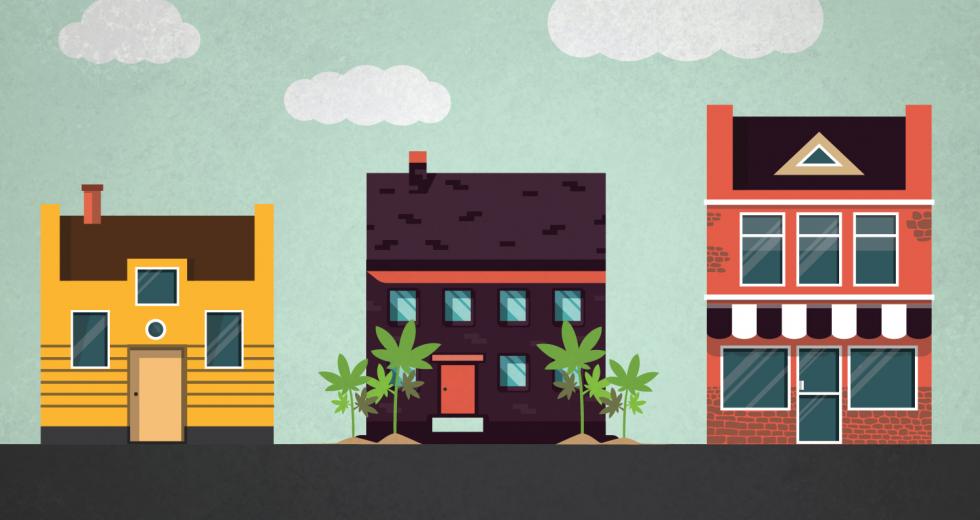Is marijuana going to be a game-changer for Sacramento real estate?
Let’s talk about that, and let’s try not to argue. Despite California’s reputation for progressiveness, marijuana is still a polarizing topic. After all, Proposition 64, which made recreational marijuana legal for adults throughout the state, only passed by 56 percent. This means nearly 1 out of every 2 voters did not approve. Or in other words, half of everyone you meet might have a different opinion than you.
The City of Sacramento does allow for the cultivation of commercial cannabis in certain areas, deemed ‘green zones,’ making it the wild child sibling of the county.
No matter your opinion, let’s take a look at how the cannabis industry is beginning to take root in Sacramento’s regional market. The goal here is to pay attention to the real estate trends happening around us.
You might think we’re going to become Potville USA since recreational marijuana is now legal in California, but local cities and counties have the right to create their own rules. To date, most throughout the greater Sacramento region have said yes to residents having the right to grow recreational marijuana inside their homes, but have largely said no to commercial cannabis cultivation. The City of Sacramento does allow for the cultivation of commercial cannabis in certain areas, deemed “green zones,” making it the wild child sibling of the county.
So, the legal marijuana industry isn’t going to look the same everywhere. In some places, it won’t even exist.
Did you know that law enforcement officials have said that more than 1,000 illegal residential grow houses may exist within Sacramento city limits alone? They are illegal because the city government does not allow commercial production on residential properties. But this is a reminder that this industry is already happening all around us.
While University of the Pacific projects the cannabis industry can create 20,000 jobs in the greater Sacramento region, we have to remember it’s a stealthy business. There’s potential to see explosive growth in this industry, but most legal grows will be in industrial locations off the beaten path of neighborhoods. Sacramento city officials hope many of the illegal residential grow houses will go legit and move to the commercial sector. We’ll see.
One of the most obvious post-election impacts we’re seeing in Sacramento has been increasing values and rents for industrial properties within designated green zones within city limits. Brian Jacks, a commercial broker, tells me standard industrial rents in the Sacramento area range from $0.50-$0.70 per square foot per month, though in some cases properly-zoned marijuana cultivation facilities, located within city limits, can command up to $2 per square foot per month or more.
On the purchase side, Realtor Tina Wilks says buyers need to have cash or at least 50 percent down to obtain a hard money loan. Understandably, we are currently seeing a price markup for commercial properties located in areas where commercial cultivation is legal.
Last year, before Prop 64 even passed, there was a “green rush” in Yolo County. Investors from all over the U.S. flooded the Capay Valley gobbling up 10-plus acre parcels suitable for outdoor cannabis cultivation. Buyers paid top dollar for these vacant lots until October 2016, when cannabis farmers could no longer obtain a permit from the Central Valley Regional Water Quality Control Board, which was a prerequisite for obtaining a cannabis cultivation permit.
I recently spoke with a homeowner in Fair Oaks who was hoping to sell his one-fourth acre lot to a marijuana grower. He was excited about his property now being worth more because of the new state law, but there were two big problems.
First, Sacramento County does not currently allow commercial cannabis cultivation. So, owning a parcel of land or industrial building in the county doesn’t mean much since zoning prohibits marijuana growers. Second, the big growers aren’t buying tiny postage stamp lots — especially in residential neighborhoods.
Just because recreational marijuana is legal in California does not mean everyone can cash in and get rich. It all comes down to having the right zoning and location for legal cannabis cultivation.
Most surrounding cities and counties have been adamant about not allowing dispensaries or commercial grows, but for how long? If the City of Sacramento does eventually generate $18 million-$20 million in annual revenue, as Councilman Jay Schenirer has publicly said is possible, don’t you think that’s going to put pressure on the rules to change in other places? Right or wrong, money has a way of altering people’s minds.
Moreover, if the cannabis industry has explosive growth in the city of Sacramento, can you imagine an eventual moratorium placed on dispensaries and commercial operations within city limits? Couldn’t this also put more pressure on other areas to allowgreen zones?
Some say Sacramento is primed to be an epicenter for marijuana cultivation, like Denver, Col., which has over 4.2 million square feet of industrial space set aside for growing cannabis. Nobody has a crystal ball though, so it’s impossible to say how exactly this trend will unfold.
Is all of this good or bad? Well, that depends on who you ask.
Recommended For You

A Breakdown of Marijuana Laws
What patients and dispensaries need to know at the federal, state, county and city levels
Sacramento City Council has outlawed outdoor cultivation by legal cannabis patients, citing public safety and smell concerns. Now, added to this ban is the classification of cannabis cultivation as wasted water: Patients are no longer allowed to water legal, indoor plants, yet there is no penalty on those growing equally-legal crops hydroponically indoors, like tomatoes or herbs. What legal right does the council have to single out this particular crop when cultivated in accordance with local and state laws?

Cannabis Can Go From Conundrum to Catalyst
Elections matter. The people have spoken. And marijuana — more appropriately known by the less pejorative label, cannabis — is now legal for adults in eight states, including California, and for those with medical needs in 28 states. That means the majority of Americans now live in states where cannabis is legal in some form.




Comments
When I was 12 years old I started smoking. Even though no one in my household smoked, and one had to be 18 or older to buy cigarettes, I had no trouble at all obtaining them. If I were 12 today, I could obtain marijuana just as easily, regardless of the law.
Tens of millions of dollars are spent today by institutions and government agencies to deter young people from smoking, to publicize the risks, including smoking prohibitions in almost all public spaces. Millions more are spent on health care for those with emphysema or lung cancer contracted from smoking, while at the same time millions of dollars are collected in taxes from the sale of tobacco products, all perfectly legal.
This cycle is now being repeated.
The cover story in January, 2037 in Comstock’s Magazine:
How marijuana use is destroying an entire generation.
The next 20 years will tell the story of why high school graduates leave with only 8th grade knowledge; why young people have a shorter attention span; why young people can’t seem to focus for any period of time; why average life span has gotten shorter; why people are physically less active (not just because of computer use); why they cannot put together a single coherent sentence; why they cannot think logically; why they are generally less knowledgeable, less intelligent (lower IQ), less capable at any profession than the previous generation. Why has the reduction in cigarette sales not reduced the cases of lung cancer and other respiratory problems? What can be done to eliminate the curse of this drug?
Cities and counties around the country, just as Sacramento, are jumping on the money train; they cannot resist the millions of dollars in fees and taxes they can collect by legalizing the sale of this drug.
The approval of permit fees was the first step in a city effort to raise $6.3 million in revenues from marijuana businesses to pay for hiring additional city staff and police over the next three years to regulate the cannabis industry in Sacramento and drive out illegal cultivators operating in neighborhoods or other zones where the businesses are prohibited. The effort is expected to require 54 positions, including 32 new city hires at a cost of $5.4 million.
On Tuesday night, the council approved first-year permit fees ranging from $9,700 for indoor grow rooms with up to 5,000 square feet of marijuana to $28,910 for facilities of up to 22,000 square feet, with the annual fees dropping to a range of $8,240 to $26,630 the second year.
And it is a drug.
Status of Marijuana at the Federal Level: Controlled Substances Act of 1970
Marijuana regulated under Schedule I, defined as having:
High potential for abuse
No currently accepted medical use
Lack of accepted safety for use under medical supervision
The money is irresistible, and will quickly become a major element in every budget. These cities and counties are, in effect, drug dealers.
In Sacramento, we have an alternative publication, called News and Review, a weekly free newsmagazine of the far left. The latest edition, Sep 14, had 12 full pages of ads for marijuana out of a total of 55 pages. This publication is pushing drugs, encouraging young people (their primary readers) to buy and use pot. I suspect pot advertising is their major revenue.
It is not even the legalization that is the most damaging: it is the normalization of use. When I started smoking at 12, it was because of the influence of movie stars such as Brando and particularly James Dean, never seen without a cigarette in his mouth.
Today pot is the new tobacco, and the results will be the same, or worse. Tobacco never contributed directly to auto accidents and death on the highway; pot, though, is now found to be a contributing factor in auto accidents and fatalities in states that have legalized pot.
The long term effects, physical, mental and emotional, of being even partially stoned are only marginally known, including the supposed medical benefits of pot.
Some of us are old enough to remember the time when alcohol was touted as a pain relief agent, and of course, if one were to have a few drinks, most minor pain would be alieved! The medical benefits are being used as the basis for legalization, and this tactic has been very successful.
It is difficult to embrace the idea that having more and more people stoned on drugs is a positive advance in our culture, yet that is where we are heading. And the people leading the charge are our elected leaders at city and county levels, for the money.
This will not end well for anyone except those selling the drug, and those rolling in the millions of dollars in taxes and fees, the drug dealers. They will make Al Capone look like a rookie. But the long term effect on the country will not be what these people think it will be.
I won’t be around to see that issue of Comstock’s, but I assure you it will happen.
Less problems for medical users, however; once it gets going the problem is what to do with ALL that money!! can't put it in a bank, that is illegal, Colorado growers are looking for closed banks to buy, monies will not be insured! Got even more fun to look forward to if the Mushroom passes. Oh maybe not, everyone will be Stoned or loosing their mind, very colorful!!